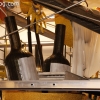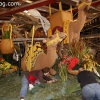If you will recall, last week I headed out to Fiesta Parade Floats to take photos of the floats they were building for the upcoming 125th Tournament of Roses Parade. It was December 23 and at that point the floats were virtual skeletons; waiting for December 26 when the actual decorating could begin. The parade rules state that all surfaces of the float framework must be covered in natural materials; usually flowers and seeds. Since these natural materials have a tendency to decay after they are plucked from the ground, the decorating does not begin until December 26. The decorating must be completed by the evening of December 30 so that the floats can be judged on December 31.
Yesterday, December 30 I headed back out to Fiesta Parade Floats in Irwindale to see how progress was coming along. The first thing I noticed was how great it smelled in there with thousands upon thousands of flowers; most already on the floats, but some still waiting to be applied. One of the volunteers told me that they got a slow start because of the extremely warm weather we have been experiencing, but it was obvious that most of the floats were very close to completion.
After I left Irwindale I headed out to the Rose Bowl Stadium parking lot, having been invited by the California Cut Flower Commission (CCFC) to come photograph the float by entered by California Polytechnic State University (Cal Poly). Last year the CCFC reached out to me because approximately 80% of all cut flowers sold in the United States are imported from other countries. The CCFC and California flower farmers were working with the Cal Poly Universities and the City of South Pasadena to ensure that more than 85% of the flowers used on their floats were American grown, specifically from Californias flower farms. This year, Cal Poly is the only certified “California Grown” float in the parade with more than 85% of the flowers used to decorate the float being sourced from California flower farmers.
From the CCFC media kit: Before the floats make their debut down Colorado Boulevard, California Department of Food and Agriculture Secretary Karen Ross, in partnership with the Buy California Marketing Agreement (BCMA) and the California Cut Flower Commission (CCFC), will recognize the students of Cal Poly Universities in a special ceremony for committing their floats to be “California Grown.” More than 85 percent of the flowers adorning the float will be sourced from California flower farmers—an industry that has a $10.3 billion annual impact on the states economy and contributes 92 cents of every dollar earned back into the states economy.
Now in its 125th year, the annual New Years Day parade in Pasadena celebrates Californias beautiful weather and bountiful flowers. It is an American tradition, yet most Americans are not aware that four out of five flowers used to decorate the floats are likely imported from South America. In fact, of all the flowers sold in the U.S. today, approximately 80 percent are grown in places like Colombia and Ecuador. Cal Poly Universities students from both the San Luis Obispo and Pomona campuses are working with flower farmers to ensure that 94 percent of the fresh flowers used on their “Bedtime Buccaneers” float are plucked straight from Californias lush flower farms.
I would like to thank the Torrance Rose Float Association and the California Cut Flower Commission for the access required to take these photos. The first half of the photos were taken at Fiesta Parade Floats in Irwindale and the second half were taken at Lot I of the Rose Bowl Stadium. Have a great 2014.
























